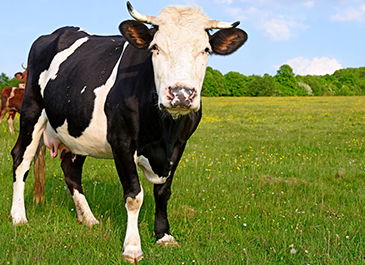Good Fodder on Grass-Fed Animals
FOOD & DRINK / WRITTEN BY NICOLE FETTERLY, RD

We all like to envision cows, goats and sheep grazing in a green pasture outside a bright red barn. Unfortunately, the reality of our livestock-raising system is generally so far from this it’s easier to turn a blind eye. Most cattle raised in North America never see the outdoors and never munch a blade of grass directly out of the ground. They’re kept in stalls in barns or in muddy feedlots and the grass they are fed is part of a feed mix that is heavily grain-based and designed to fatten them up as quickly as possible. This is a less than idyllic life for these animals and means the meat and milk from them is much different in nutritional quality.
Extensive research is emerging that compares the meat and milk quality of exclusively grass-fed animals to conventional ones. The first nutrients that emerge in the grass-fed model are essential fatty acids, especially conjugated linoleic acid or CLA, an omega-6 fatty acid. The quantity of CLA can be up to 3 to 6 times higher than in conventional milk and meat. More importantly, the omega-6 to omega-3 ratio is improved, due to higher concentrations of omega-3 in grass-fed products. This change in fat proportions and quantities can lead to decreased inflammation in our bodies. The amount of total fat, certain saturated fats and cholesterol are also significantly less with exclusive grass-feeding, which may reduce cardiovascular disease risk.
Other nutrients prominent in grass-fed products are vitamin A/beta-carotene (which can give a yellow tinge to the meat or dairy), vitamin E, certain B vitamins and other antioxidants. Often the concentration of these nutrients will naturally vary with the seasons as the cows consume different flora that emerges in the pasture.
Why is there such a difference when these animals are fed a grass-only diet? Well, cows are part of an animal family called ruminants that digest their food very differently than we do. They’re meant to eat grass all day long, chewing their cud, until they mechanically and enzymatically break it down to absorbable nutrients. On the other hand, when cows eat grains the condition of their stomach changes, leading to acidosis. This often causes ulcers, which can require antibiotics and some conventional operations give low-dose antibiotics prophylactically because this condition is so common. Cows pastured exclusively on grass have much less stress, illness and also have less risk of passing on harmful bacteria, like E.coli and campylobacter.
There are numerous grass-fed products showing up in the marketplace: yogurt, milk, cheese, butter, beef, lamb and bison meat. It’s important to note however that the term “grass-fed” is NOT regulated by the Canadian Food Inspection Agency as of yet. To determine with certainty at the moment, the only option is to know the producer and look for the term “100% grass-fed.”
Companies like Natural Pastures on Vancouver Island are the absolute gold standard. Another company to watch is Tree Island Yogurt—not only does their yogurt taste incredible, but they’re also leading the industry in promoting a better standard for dairy cows. Rolling Meadow Dairy is a new 100% Canadian, grass-fed milk, yogurt, butter producer out there. And, stay tuned for a locally produced grass-fed lamb coming later this year.

